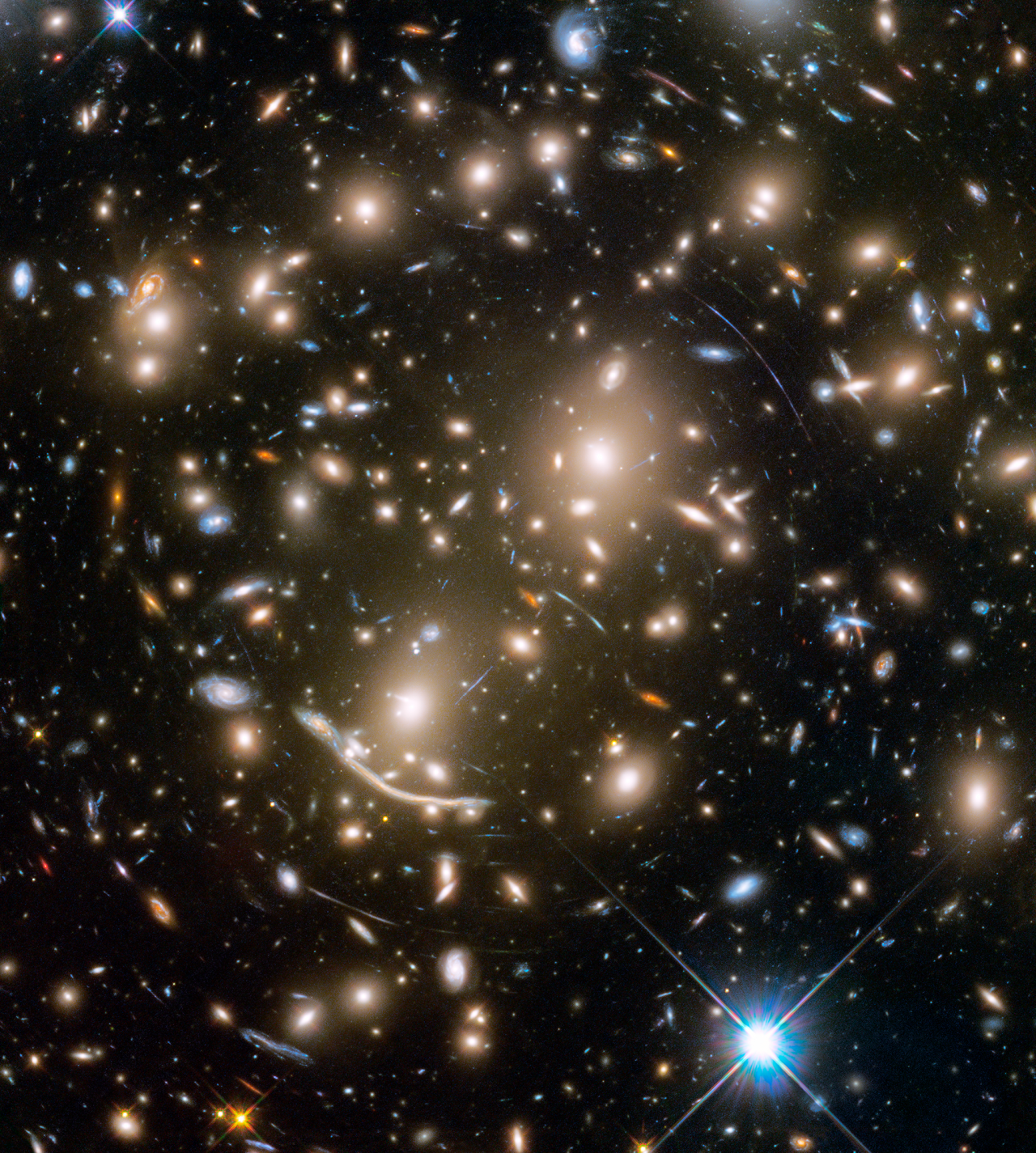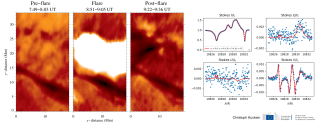Grants related:
General
Galaxies in the universe can be located in different environments, some of them are isolated or in low density regions and they are usually called field galaxies. The others can be located in galaxy associations, going from loose groups to clusters or even superclusters of galaxies. One of the foremost challenges of the modern Astrophysics is to achieve a complete theory about galaxy evolution. This theory should explain the relation between the environment and galaxy evolution. Galaxy clusters are high density environments where galaxies interact one to each other and with the intracluster material (ICM). In addition, the cluster dynamics is driven by the high density and quantity of dark matter present in them. Therefore, galaxy clusters are complex systems with multiple components (galaxies, ICM, dark matter) which are tightly bounded. The mix of all these components, as well as their interactions, makes galaxy clusters ideal laboratories to study the different mechanisms which cause the different evolution of galaxies in this high density environments with respect to field galaxies.
The objective of this project is to study the formation and evolution of galaxies in these dense environments. The ‘Galaxy Evolution in Clusters’ group intend to understand in what environment each of the mechanisms proposed by numerical simulations to transform the galaxies dominates and how the evolution of the different types of galaxies (both bright and dwarf) occurs in the clusters. Quantifying observationally the efficiency of these mechanisms is not an easy task since many of them act at the same time, they do it in very different time scales, and in diverse regions of the cluster. However, there are some observational evidences that can be directly contrasted: i) morphological and structural distribution of the galaxies of the clusters; ii) luminosity function of galaxies in clusters; iii) diffuse light (quantity and distribution); iv) presence of galactic substructures within the clusters; v) spectro-photometric properties of dwarf and bright galaxies; vi) ICM properties. All these observables provide the necessary information to understand the relationship between environment and galactic evolution. These are the quantities this project aims at measuring for large samples of galaxy clusters.
Members
Results
- Intrinsic Shape of Galactic Bars. We find, for the first time, that 52% (16%) of bulges are thicker (flatter) than the surrounding bar. We suggest that these percentages might be representative of the fraction of classical and disc-like bulges in our sample, respectively.
- The Influence of the Environment in the Star Formation Quenching. Our results indicate that in low-density environments, post-starburst galaxies are formed by gas-rich minor mergers or accretions, whereas for high-density environments PSBs would be produced by the removal of the gas reservoirs of emission line galaxies by ram-pressure stripping.
- Morpho-Kinematic Properties of Galactic Bulges. We find that photometric diagnostics to separate different types of bulges (disc-like versus classical) might not be useful for S0 galaxies. Using the morpho-kinematics properties of S0 bulges derived in this paper we suggest that they are mainly formed by dissipational processes happening at high redshift.
Scientific activity
Related publications
-
Aperture corrections for disk galaxy properties derived from the CALIFA survey. Balmer emission lines in spiral galaxies
This work investigates the effect of the aperture size on derived galaxy properties for which we have spatially-resolved optical spectra. We focus on some indicators of star formation activity and dust attenuation for spiral galaxies that have been widely used in previous work on galaxy evolution. We investigated 104 spiral galaxies from the CALIFA
Iglesias-Páramo, J. et al.Advertised on:
52013 -
X-ray emission from RX J1720.1+2638 and Abell 267: A comparison between a fossil and a non-fossil system
We present the XMM-Newton X-ray analysis of RX J1720.1+2638 and Abell 267, a non-fossil and a fossil system, respectively. The whole spectrum of both objects can be explained by thermal emission. The luminosities found for RX J1720.1+2638 and Abell 267 in the 2-10 keV band are 6.20+0.04-0.02{×}1044 and 3.90+0.10-0.11{×}1044 erg s-1, respectively
Jiménez-Bailón, E. et al.Advertised on:
42013 -
Evolution along the sequence of S0 Hubble types induced by dry minor mergers. II. Bulge-disk coupling in the photometric relations through merger-induced internal secular evolution
Context. Galaxy mergers are widely discussed as one possible evolution mechanism for lenticular galaxies (S0s), because even minor mergers induce structural changes that are difficult to reconcile with the strong bulge-disk coupling observed in the photometric scaling relations of these galaxies. Aims: We check if the evolution induced onto S0s by
Prieto, M. et al.Advertised on:
42013 -
The puzzling merging cluster Abell 1914: new insights from the kinematics of member galaxies
We analyse the dynamical state of Abell 1914, a merging cluster hosting a radio halo, quite unusual for its structure. Our study considers spectroscopic data for 119 galaxies obtained with the Italian Telescopio Nazionale Galileo. We select 89 cluster members from spatial and velocity distributions. We also use photometry Canada-France-Hawaii
Boschin, W. et al.Advertised on:
42013 -
The impact of galaxy harassment on the globular cluster systems of early-type cluster dwarf galaxies
The dynamics of globular cluster systems (GCSs) around galaxies are often used to assess the total enclosed mass, and even to constrain the dark matter distribution. The GCS of a galaxy is typically assumed to be in dynamical equilibrium within the potential of the host galaxy. However cluster galaxies are subjected to a rapidly evolving and, at
Farias, J. P. et al.Advertised on:
22013 -
CALIFA, the Calar Alto Legacy Integral Field Area survey. II. First public data release
We present the first public data release (DR1) of the Calar Alto Legacy Integral Field Area (CALIFA) survey. It consists of science-grade optical datacubes for the first 100 of eventually 600 nearby (0.005 < z < 0.03) galaxies, obtained with the integral-field spectrograph PMAS/PPak mounted on the 3.5 m telescope at the Calar Alto observatory. The
Ziegler, B. et al.Advertised on:
12013 -
The Nature and Nurture of Bars and Disks
The effects that interactions produce on galaxy disks and how they modify the subsequent formation of bars need to be distinguished to fully understand the relationship between bars and environment. To this aim we derive the bar fraction in three different environments ranging from the field to Virgo and Coma Clusters, covering an unprecedentedly
Méndez-Abreu, J. et al.Advertised on:
122012 -
Structure of Abell 1995 from optical and X-ray data: a galaxy cluster with an elongated radio halo
Context. Abell 1995 is a puzzling galaxy cluster hosting a powerful radio halo, but it has not yet been recognized as a obvious cluster merger, as usually expected for clusters with diffuse radio emission. Aims: We aim at an exhaustive analysis of the internal structure of Abell 1995 to verify that this cluster is really dynamically relaxed, as
Boschin, W. et al.Advertised on:
112012 -
Evolution along the sequence of S0 Hubble types induced by dry minor mergers. I. Global bulge-to-disk structural relations
Context. Recent studies have argued that galaxy mergers are not important drivers for the evolution of S0's, on the basis that mergers cannot preserve the coupling between the bulge and disk scale-lengths observed in these galaxies and the lack of correlation of their ratio with the S0 Hubble type. However, about 70% of present-day S0's reside in
Eliche-Moral, M. C. et al.Advertised on:
112012 -
Structure and Dynamics of the Central Regions of Disk Galaxies
Not Available
Méndez-Abreu, JairoAdvertised on:
62009 -
Structure and dynamics of galaxies with a low surface-brightness disc - II. Stellar populations of bulges
We present the radial profiles of the Hβ, Mg and Fe line-strength indices for a sample of eight spiral galaxies with a low-surface-brightness stellar disc and a bulge. The correlations between the central values of the line-strength indices and velocity dispersion are consistent with those known for early-type galaxies and bulges of high-surface
Morelli, L. et al.Advertised on:
62012 -
Structure and dynamics of galaxies with a low surface-brightness disc - I. The stellar and ionized-gas kinematics
Photometry and long-slit spectroscopy are presented for a sample of six galaxies with a low surface-brightness stellar disc and a bulge. The characterizing parameters of the bulge and disc components were derived by means of a two-dimensional photometric decomposition of the images of the sample galaxies. Their surface-brightness distribution was
Pizzella, A. et al.Advertised on:
72008 -
Stellar populations of bulges in 14 cluster disc galaxies
Photometry and long-slit spectroscopy are presented for 14 S0 and spiral galaxies of the Fornax, Eridanus and Pegasus cluster, and NGC 7582 group. The structural parameters of the galaxies are derived from the R-band images by performing a two-dimensional photometric decomposition of the surface brightness distribution. This is assumed to be the
Morelli, L. et al.Advertised on:
92008 -
Polar bulges and polar nuclear discs: the case of NGC 4698
The early-type spiral NGC 4698 is known to host a nuclear disc of gas and stars which is rotating perpendicularly with respect to the galaxy main disc. In addition, the bulge and main disc are characterized by a remarkable geometrical decoupling. Indeed, they appear elongated orthogonally to each other. In this work, the complex structure of the
Corsini, E. M. et al.Advertised on:
62012 -
The Hubble Space Telescope Advanced Camera for Surveys Coma Cluster Survey. I. Survey Objectives and Design
We describe the HST ACS Coma Cluster Treasury survey, a deep two-passband imaging survey of one of the nearest rich clusters of galaxies, the Coma Cluster (Abell 1656). The survey was designed to cover an area of 740 arcmin2 in regions of different density of both galaxies and intergalactic medium within the cluster. The ACS failure of 2007 January
Carter, David et al.Advertised on:
62008 -
The HST/ACS Coma Cluster Survey. II. Data Description and Source Catalogs
The Coma cluster, Abell 1656, was the target of an HST-ACS Treasury program designed for deep imaging in the F475W and F814W passbands. Although our survey was interrupted by the ACS instrument failure in early 2007, the partially completed survey still covers ~50% of the core high-density region in Coma. Observations were performed for 25 fields
Hammer, Derek et al.Advertised on:
112010 -
The complex structure of Abell 2345: a galaxy cluster with non-symmetric radio relics
Context. The connection of cluster mergers with the presence of extended, diffuse radio sources in galaxy clusters is still debated. Aims: We aim to obtain new insights into the internal dynamics of the cluster Abell 2345. This cluster exhibits two non-symmetric radio relics well studied through recent, deep radio data. Methods: Our analysis is
Boschin, W. et al.Advertised on:
102010 -
Orbit determination of close binary systems using lucky imaging
We present relative positions of visual binaries observed in 2009 with the FastCam 'lucky-imaging' camera mounted on the 1.5-m Carlos Sánchez Telescope at the Observatorio del Teide. We obtained 424 CCD observations (averaged in 198 mean relative positions) of 157 binaries with angular separations in the range 0.14-15.40 arcsec, with a median
Rica, F. M. et al.Advertised on:
12012 -
Optical analysis of the poor clusters Abell 610, Abell 725, and Abell 796, containing diffuse radio sources
Aims: We study the dynamical status of the poor, low X-ray luminous galaxy clusters Abell 610, Abell 725, and Abell 796 (at z = 0.1, 0.09, and 0.16, respectively), containing diffuse radio sources (relic, relic, and possible halo, respectively). Methods: Our analysis is based on new spectroscopic data obtained at the William Herschel Telescope for
Boschin, W. et al.Advertised on:
82008 -
Internal dynamics of the galaxy cluster Abell 959
Context: The connection of cluster mergers with the presence of extended, diffuse radio sources in galaxy clusters is still being debated. Aims: We aim to obtain new insights into the internal dynamics of Abell 959, showing evidence of a diffuse radio source, analyzing velocities and positions of member galaxies. Methods: Our analysis is based on
Boschin, W. et al.Advertised on:
22009


